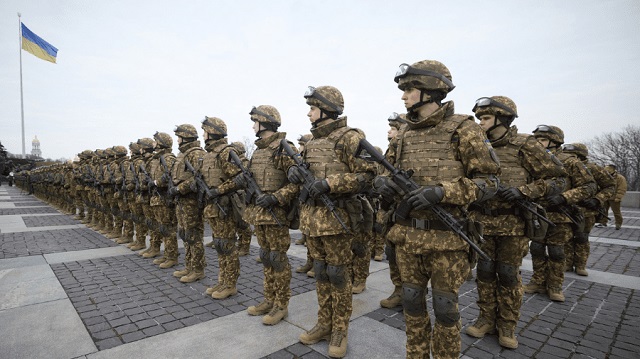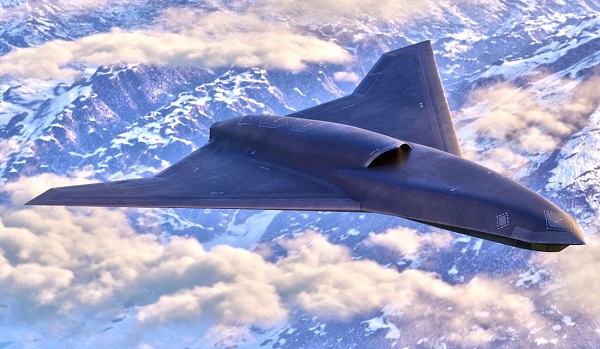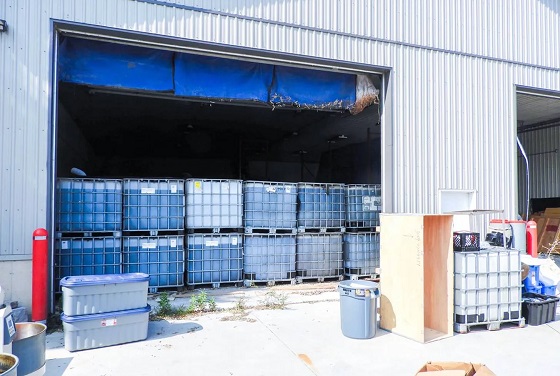armed forces
We are witnessing the future of war on the battlefields of Ukraine

From the MacDonald Laurier Institute
By Richard Shimooka
We would be wise to learn the lessons the Ukrainians have fought so hard to learn
Historically, certain wars have stimulated the development of future defence thinking. The 1905 Russo-Japanese War previewed many features of the Great War a decade later, including the lethality of machine guns and howitzers, as well as the ubiquity of trench warfare. The 1973 Yom Kippur War between Israel and its Arab Neighbours was particularly influential for present wars—the Arab combatants’ use of new anti-tank guided missiles challenged many existing doctrines. This is not to say that all groups absorb the lessons directly or effectively. Many of the great powers, including Russia (who fought in the 1905 war), failed to adopt the lessons laid bare in that conflict and suffered grievous casualties in the first years of World War I as a result.
Approaching two years since the invasion, the war in Ukraine has the potential to have an outside impact on the future of war for a variety of reasons. Its timing comes as a number of new technologies have emerged, many of which have come from the civilian space. These include the proliferation of drones, low-cost satellites, and high bandwidth networking—all of which to date have had major effects on the outcome of the war.1 Over the past two years, both sides have adapted their doctrine and capabilities to reflect a cycle of learning and adaptation which gives a clearer understanding of where these technologies are headed.
Some of these trends are a validation of overriding trends in warfare, particularly around the collection and use of data afforded by networked systems. This is evident in the maturation of the “reconnaissance-strike” complexes in Russian and Ukrainian doctrine. Essentially, this is a streamlining of the process of identifying and attacking targets with precision fire, usually from some form of artillery. The United States and NATO have been pursuing a roughly similar—but much more advanced and all-encompassing—concept known as “multi-domain operations.” There are several common denominators between both doctrines, including the effort to expand detection over wider areas, as well as hastening the decision-making process which can improve the lethality of any weapon system attached to it. While it may not be able to employ traditional airpower, the use of long-range artillery (including the recently provided ATACMS missile system) shows the effectiveness of this approach to war. It also allows for a greater economy of force—a critical consideration for Ukraine due to its disadvantageous economic and strategic situation facing a state three times its size.
A key feature of progress in this area is its organic nature. Since the start of direct hostilities in 2014, Ukraine has done well to build up some of these connective capabilities adapting civilian systems for military purposes, such as the Starlink satellite network and apps for mobile devices. A large portion are ground-up approaches, developed even by military units to suit their particular operational needs. This was part of the total war approach that the Ukrainian government has instituted, often leveraging their emerging tech industries to develop new capabilities to fight against the Russian Federation. Many allies have similar efforts, but too often focus remains on a very centralized, top-down approach, which has led to substandard outcomes. Some balance between the two poles is likely ideal.
Another major consideration is the revolutionary impact of drones on air warfare. Traditional manned airpower, like F-16, Mig-29s, and even attack helicopters, remain as relevant as ever in Ukraine. While no side possesses true air superiority, some localized control has been established for short periods, resulting in potentially decisive consequences. However, the war has followed the trend of other recent wars with low-cost, attritable drones playing an important role. While this has been evident in the strike-reconnaissance doctrine discussed above, the so-called kamikaze loitering drones, such as the Russian Lancet and armed first-person view commercial drones, have played an important role as well.
One important aspect is what is known as the “mass” of these capabilities—not individually, but as a collective system or swarm of multiple individual units that can be lost without a major degradation of their lethality. At present, the link between traditional and emerging airpower domains is fairly disjointed over the battlefield in Ukraine, perhaps due to lingering service parochialism. But once combined they will only multiply each other’s lethality.
There is, however, one question concerning this new frontier of airpower’s ultimate influence in the future. It hinges significantly on the efficacy of new anti-drone systems, like those being developed by the United States Army and NATO allies. These potentially may blunt or even remove the deadly threat these UAVs pose to modern ground forces. But as of now they are in their infancy and very few are present in Ukraine today. If they are unable to make a major impact, then the future of conflict will be radically different.
Over the past thirty years, Canada, the United States, and its allies have often been able to deploy troops abroad to many stabilization and peacekeeping missions, in part due to the relatively benign threat environment they were entering. There was confidence that deployed soldiers would not incur significant casualties, which would arouse domestic opposition to the missions themselves. If the lethality of these unmanned drone systems remains unchecked, then, considering their greater ubiquity, it may drastically constrain the ability of Western countries to intervene and assert their muscle abroad, even in low-risk environments.
Finally, and perhaps most critically, is the need for an adaptive defence industrial base (another word for military supply chains) with the capacity to meet a wide need for war. The Russian Federation, for example, faced wide-ranging and intrusive sanctions from the start of the conflict that precluded them from obtaining a number of key resources for their war effort, ranging from raw materials to advanced technology components. They have been able to weather these challenges due to a combination of factors: a deliberate effort to develop an autarkic industrial base that started after 2014, a less technologically advanced military, and sanctions-avoiding policies such as smuggling and diversifying their foreign supplier base to more reliable allies.
While Western allies are unlikely to face the same restrictions in a potential future conflict on the scale that Russia has, in some ways they have greater challenges. These countries rely on much more sophisticated military capabilities that have levels of complexity far in excess of Russian systems. The sheer diversity in all of the raw materials inputs and various subcomponent providers, as well as the networks to make them all work, means that they are actually much easier to disrupt. Shades of this were evident during the initial months of the COVID-19 epidemic when the production of civilian goods was affected by shortages and supply chain disruptions.
Furthermore, underinvestment in the defence industrial base has left the capacity to ramp up production in most areas perilously slow, even two years after the conflict started.
More effort must be spent on creating a much more resilient industrial base that has the capacity to ramp up production to meet the needs of modern war. This requires significant front-end investment by governments in capacity building as no private firm is willing to spend money in that fashion without any guarantee of a return. At the same time, building capacity must be targeted and appropriate to the actual needs of Canada and its allies—taking lessons from Ukraine without understanding their context would be a mistake. That war and its material demands are unique to it.2 Discerning the actual needs and developing accordingly should be done through careful analysis and wargaming, much like the recent Center for Strategic International Studies analysis on U.S. missile needs in a potential war against China has done.
In the end, a clear trend that seems to bind all of these areas is the need for adaptability and critical thinking. Warfare is fast becoming more lethal and decisive. Modern armies must be able to respond to those changes as quickly as they occur—or better yet, lead those changes against their adversaries. That, for one, cannot occur in an organization that is continually starved for funding like the Canadian Armed Forces is today.
But it may also require a radical reorganization and re-think of how defence policy, strategy, operations, and doctrine are developed and implemented—not to mention personnel and industrial policy. As the conflict in Ukraine has laid bare, bringing in the brightest minds and giving them greater leeway to develop responses is key, as is harnessing the potential and building the capacity of domestic industrial bases. These are essential and urgent lessons we must learn. They have been hard won by the sacrifices of the Ukrainian people for our benefit. It would be a shame to waste them.
Richard Shimooka is a Hub contributing writer and a senior fellow at the Macdonald-Laurier Institute who writes on defence policy.
armed forces
Underfunded and undermanned, Canada’s Reserves are facing a crisis

The Macdonald Laurier Institute
By J.L. Granatstein for Inside Policy
With the new threats facing Canada and NATO, change must come quickly: Canada needs to fix the Army Reserves.
Canada’s once-proud Reserves force is fading fast – and without urgent action, it risks becoming irrelevant.
The Canadian Armed Forces Primary Reserves have an authorized strength of 30,000, but the present numbers of the Army, Navy and Air Force Reserves as of November 2024 are only 22,024. The RCN Reserves number 3,045, the RCAF 2,162, and the Army 16,817. This is frankly pathetic, all the more so as the regular forces are sadly understrength as well.
The Army Reserves have a long history, with some units dating back before Confederation. Before both world wars the Militia’s strength was roughly 50,000, generated by populations of eight million in 1914 and eleven million in 1939. Amazingly, despite a lack of training and equipment, the Militia provided many of the Army’s officers, up to and including successful division and regimental commanders, and large numbers of the senior non-commissioned officers. A century ago, even after some consolidation following the Great War, almost every town and city had an armoury and a Militia unit with a cadre of officers, good numbers of enlisted men, and some social status in their community. The factory owners, bankers, and well-off were heavily represented, and the Militia had real clout with representation in Parliament and easy access to the defence minister.
Not any longer. The armouries in most of Canada have disappeared, sold off by governments and levelled by developers, and those that still stand are in serious need of maintenance. The local elites – except for honorary colonels who donate funds for extra kit, travel, celebratory volumes, and to try to stop Ottawa from killing their regiment – are noticeably absent.
So too are the working men and women and students. As a result, there are Army Reserve units commanded by a lieutenant-colonel with three majors, half a dozen captains, ten lieutenants, a regimental sergeant major and any number of warrant officers, and under seventy in the ranks. It is a rare Reserve regiment, even those in Canada’s largest cities, which has a strength above 200, and ordinarily when a unit trains on a weeknight or a weekend only half that number turn up. Even in summer, when reservists do their serious training at Petawawa or other large bases, there will be many absentees.
And when a unit is asked to raise soldiers for an overseas posting – say for the Canadian-led brigade in Latvia – it might be able to find ten or so volunteers, but it will be highly unlikely to be able to do so when the next call comes. Reservists have families, jobs or school classes, and few are able and willing to go overseas and even fewer to do so for subsequent deployments.
Without reservists filling the ranks (and even with them providing up to 20 per cent of a battalion’s strength), the undermanned regulars must cobble together a battalion of 600 or so by seconding troops from another Regular unit. After being brought up to Regular force standards before deployment, the reservists have performed well in operations, for example, in Afghanistan.
So why can’t the Army Reserves find the men and women to join their ranks? The reasons are many and much the same as the recruitment difficulties facing the Regular Army. Sexual harassment cases have abounded, affecting the highest ranks and the lowest. Modern equipment has been and is continuing to be lacking.
Procurement is still bogged down with process, paperwork, and long timelines – for instance, approving a new pistol took a decade. And the Reserves get modern equipment only after the Regulars’ needs are met, which unfortunately means never. Instead of a tank or a Light Armoured Vehicle, units get pickup vehicles painted in dark green and see anything more only on their rare days of training in the field.
Leaders of the Reserves have called for a separate budget for years, demanding that they decide how the funds are allocated. National Defence Headquarters has refused, rightly claiming that the underfunded Regulars have higher priority. But the Reserves point to official documents that in 2019-20 demonstrated that of $3.018 million allocated to the Reserves, only $1.3 billion reached them, the rest being unspent or re-allocated to the Regulars.
With some reason this infuriates Reservists who point to this happening every fiscal year.
So too does what they see as the condescension with which they are treated. A Reserve major is equal in rank to a Regular major, but both know that the Regular is almost always far better trained and experienced for his job and that rankles. (Many years ago, when I was a junior officer, I remember another Regular referring to “the ****ing Militia.” I know that Reserve officers reverse the compliment.)

Today with unemployment above nine per cent and with young Canadians’ unemployment rate even higher, the Reserves pay a new private a daily rate of some $125 (The Carney government recently promised a substantial pay raise). This ought to be a good option to earn some money. The Toronto Scottish, an old and established infantry unit, for example, has a website that lists other benefits: up to $8,000 for educational expenses and up to $16,000 for full-time summer employment. The Toronto Scottish has two armouries in the western suburbs, a female Commanding Officer, but under 200 soldiers. There should be a real opportunity in the current circumstances to increase those numbers by a good advertising campaign pitched directly at young men and women in the Toronto suburbs. The same can be said for every big city.
But the small town and rural units, tiny regiments whatever their storied histories, are unlikely to be able to grow very much. National Defence Headquarters needs to set a number – say 150, 200, or 250 – above which a unit will keep its command structure. Below that standard, however, units will be stripped of their higher ranks and effectively consolidated under the Reserve brigade in their area.
Reservists have fought such suggestions for years, but if the Reserves are to become an efficient and effective force, this is a change that must come. One such experiment has combined the Princess of Wales Own Regiment in Kingston, Ontario, and the Brockville Rifles by putting the Commanding Officer of the first and the Regimental Sergeant Major of the second in charge. Unit badges can remain, but this reduces the inflated command staffs.
In reality, these small regiments are nothing more than company-sized sub-units, and sub-units of less than a hundred simply cannot train effectively or draw enough new members from their small town and rural catchment areas. Combined they can function effectively.
The federal government will soon release an army modernization plan. Change is always difficult but with the new threats facing Canada and NATO, change must come quickly. Canada needs to fix the Army Reserves.
Historian J.L. Granatstein is a member of the Macdonald-Laurier Institute’s Research Advisory Board. A bestselling author, Granatstein was the director and CEO of the Canadian War Museum. In 1995, he served on the Special Commission on the Restructuring of the Reserves.
armed forces
Secretive Lockheed Martin Skunk Works reveals latest high-tech military drone

 THE MAKICHUK REPORT
THE MAKICHUK REPORT
Unmanned Vectis to ride shotgun with next-gen fighters
When Lockheed Martin’s super secret Skunk Works© advanced development arm unveils a new project, the aviation world stops and listens.
As always, it is very hush-hush, and, quite often, groundbreaking.
This week’s announcement didn’t disappoint.
It’s called “Vectis” — a stealthy autonomous drone that Lockheed intends to fly by the end of 2027.
As with most Skunk Works projects, officials declined to comment on certain aspects of the aircraft’s design, such as its engine or top speed, though it was noted that Lockheed’s analysis “doesn’t point toward supersonic [speeds]” as a requirement.
What do we know about it, aside from it’s very cool, futuristic design?
The first Vectis prototype is currently “in progress,” and is envisioned as a large “Category 5” reusable drone designed to be customizable to match shifts in the threat environment, said OJ Sanchez, Skunk Works’s vice president and general manager.
“Vectis provides best-in-class survivability at the CCA [Collaborative Combat Aircraft] price point,” Sanchez told reporters ahead of the Air Force Association’s Air Space and Cyber conference in Washington, D.C. “Prototype parts are ordered, the team is in work, and we intend to fly in the next two years.”
According to Breaking Defense, Lockheed sees the range, endurance and flexibility of Vectis’s design as key to its appeal.
It is being developed for the US and international markets based on feedback from multiple customers about the future battlefield.
One has to only look at the Russia-Ukraine conflict, to see that things have changed.
Vectis can carry out mission sets ranging from air-to-air, air-to-ground and ISR, and has an open systems architecture allowing it to interface with platforms and mission systems not built by Lockheed Martin, Breaking Defense, reported.
Certain aspects of the drone — such as which payloads it can carry, or whether it is optimized for regular operations or used less frequently on deployments — can be fine-tuned to meet a customer’s specific requirements.
For instance, “we will have built into it the ability for it to be a daily flyer, reliably work alongside its crew teammates, to be able to integrate into operations for training, as well as for deployment,” Sanchez said.
“At the same time, if the requirement is ease of storage and ease of assembly, it’s absolutely built into the design. … That’s where we’ll work closely to listen with any individual customers and go from there on their operations choice, but the flexibility is built in.”
With the lessons of Ukraine in mind, Vectis is designed to be maintainable in a deployed environment, with a simple design made of “and durable, reliable materials” and easy access to the aircraft’s internal systems if repairs need to be made.
While it has not flown, Lockheed has conducted operational analysis and simulations that paired the drone with the F-22 and F-35, with Sanchez noting that its low-observable signature and communications gear are “compatible” with fifth- and sixth-generation aircraft.
It was also informed by previous experience designing tailless aircraft like the X-44 MANTA, Lockheed’s sixth-generation fighter prototype for the Air Force’s Next Generational Air Dominance program, Sanchez said.
“We’re building in that kind of autonomy, that flexible autonomy, if you will, so that we can work with more countries, more partners, to really listen to what their needs are,” he said.
“That flexibility has been demonstrated through multiple demonstrations. Now we’ll go out and build it, and we’ll work to prove in the open air.”
In the U.S. military’s parlance, Group 5 uncrewed aerial systems are the largest and most capable, covering anything pilotless with a maximum takeoff weight of 1,320 pounds or more, and that can fly at altitudes of 18,000 feet or higher.
When asked, Sanchez declined to offer any hard dimensions or other specifications for Vectis. He did say it was smaller than a Lockheed Martin F-16 fighter, but larger than one of the company’s Common Multi-Mission Truck (CMMT, pronounced ‘comet’) missile-like drones, which is a very broad size range.
According to experts at TWZ.com, renderings of Vectis from Skunk Works show a tailless drone with a lambda wing planform and a top-mounted air intake.
There is a pronounced chine line around the forward end of the fuselage and a shovel-like shape to the nose, as well as various conformal antennas and/or sensor apertures, all of which are indicative of low-observable (stealthy) design considerations.
A short promotional video also includes a cutaway view showing an S-shaped duct behind the air intake and exhaust shrouding, features that offer further radar cross-section and infrared signature reducing benefits.
Vectis’ core planform is interestingly reminiscent, in some broad strokes, of a rendering of a stealthy aerial refueling tanker concept Skunk Works first showed publicly last year.
That aircraft had a much larger design, in line with its intended mission, with large clipped wings that had some lambda-wing attributes, as well as small outwardly-canted twin vertical tails.
There has been something of an uptick in recent years in new crewed and uncrewed tactical aircraft designs with lambda or at least lambda-like planforms.
This includes one of the several air combat drone designs that emerged around a massive military parade in China earlier this month, as well as one of the two Chinese next-generation crewed combat jets that broke cover in December 2024.
Vectis also has “endurance ranges compatible with Indo-Pacific, European, and CENTCOM [U.S. Central Command] theaters,” according to a Lockheed Martin press release.
What munitions and other payloads Vectis might be able to carry is unclear. Skunk Works’ Sanchez mentioned “reusable or flexible payloads,” but did not elaborate.
The promotional video shows a vignette in which the drones, operating together with an F-22, use unspecified sensors to spot and track aerial threats before being ordered to fire air-to-air missiles, presumably from internal bays, at those targets.
Electronic warfare suites and signal relay packages might also be among the payload options for Vectis drones.
Sanchez did not provide any hard cost metrics for Vectis. The Air Force has said in the past that it is aiming for a unit cost roughly in the US$20 million range for drones being developed under the first phase, or Increment 1, of its CCA program.
In discussing how Vectis could be adaptable to multiple U.S. and foreign operator requirements, Sanchez also spoke in more detail about the drone’s current dependence on traditional runways, as well as its ability to operate from more austere locations.
“Our analysis aligns with the U.S. Air Force, that runway accessibility is incredibly important in every theatre, particularly in INDOPACOM [the U.S. Indo-Pacific Command area of responsibility]. So we’re very intentional about the flexibility that this system would enable in the theaters of interest,” Sanchez explained.
“And so the amount of runways that will be available, the amount of flexibility to implement, whether it be an Agile Combat Employment approach, or a hub and spoke for other countries, depending on how it is, Vectis will be very capable in those spaces.”
Exactly how Skunk Works envisions the Vectis will handle counter-drone weapons, such as Israel’s Iron Dome, Iron Beam, or David’s Sling, remains uncertain.
THE MAKICHUK REPORT is free today.
You can tell THE MAKICHUK REPORT that their writing is valuable by pledging a future subscription.
You won’t be charged unless they enable payments.
-

 National20 hours ago
National20 hours agoCanadian MPs order ethics investigation into Mark Carney’s corporate interests
-

 Business2 days ago
Business2 days agoCanada has given $109 million to Communist China for ‘sustainable development’ since 2015
-

 Banks1 day ago
Banks1 day agoBank of Canada Cuts Rates to 2.25%, Warns of Structural Economic Damage
-

 Opinion2 days ago
Opinion2 days agoBritish Columbians protest Trump while Eby brings their province to its knees
-

 Business1 day ago
Business1 day agoFord’s Liquor War Trades Economic Freedom For Political Theatre
-

 International2 days ago
International2 days agoStrongest hurricane in 174 years makes landfall in Jamaica
-

 Bruce Dowbiggin8 hours ago
Bruce Dowbiggin8 hours agoGet Ready: Your House May Not Be Yours Much Longer
-

 Alberta15 hours ago
Alberta15 hours agoNobel Prize nods to Alberta innovation in carbon capture









